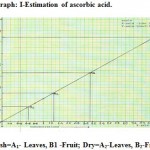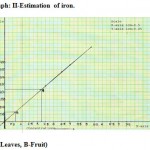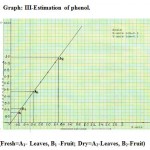Manuscript accepted on : September 11, 2009
Published online on: 28-12-2009
Evaluation of Antioxidants from Tinospora Cordifolia
K. D. Jadhao1, D. V. Badwe1, M. P. Wadekar2 and Meena Iqbal3
1Department of Botany,Government Vidarbha Institute of Science and Humanities Amravati - 444 604 India.
2Department of Chemistry, Government Vidarbha Institute of Science and Humanities Amravati - 444 604 India.
3Department of Biotechnology, Saifia College of Science & Education, Bhopal - 462 001 India.
Corresponding Author E-mail: murliwadekar@gmail.com
ABSTRACT: Tinospora cordifolia grown in wild in Melghat. It is known in Sanskrit as “Amrita”, in Hindi “Gulbel” or “Biloe” and in Marathi “Gulvel”. It is bitter, astringent, sweet, thermogenic, digestive etc. the present investigation was undertaken to estimate antioxidants from this species is only due to its multipurpose therapeutic values. The plants were collected from Melghat (Dist. Amravati). Identification were done with the help of standard floras. Fresh as well as shade dried plant material, leaves and fruit was used for moisture content and estimation of ascorbic acid, anthocyanin, iron, phenol, lycopene and carotene .Fresh leaves contain 360 mg ascorbic acid, 10.43 mg lycopene, 5.24 mg carotene, 20.296 mg anthocyanin, 400 mg phenol and dry leaves contain 290 mg ascorbic acid, 125 mg iron, 21.234 mg anthocyanin, 1240 mg phenol/100g .Fresh fruit shows 40 mg ascorbic acid, 0.6709 mg lycopene, 6.36 mg carotene, 19.355 mg anthocyanin, 560 mg phenol and dry fruit shows 3660 mg ascorbic acid, 37.5 mg iron, 19.061 mg anthocyanin, 2600 mg phenol/100 g .
KEYWORDS: Tinospora cordifolia; Antioxidant
Download this article as:| Copy the following to cite this article: Jadhao. K. D, Badwe. D. V, Wadekar. M. P, Iqbal. M. Evaluation of Antioxidants from Tinospora Cordifolia. Biosci Biotechnol Res Asia 2009;6(2) |
| Copy the following to cite this URL: Jadhao. K. D, Badwe. D. V, Wadekar. M. P, Iqbal. M. Evaluation of Antioxidants from Tinospora Cordifolia. Biosci Biotechnol Res Asia 2009;6(2). Available from: https://www.biotech-asia.org/?p=8993. |
Introduction
In recent years there is an upsurge in the areas related to new development in prevention of disease especially the role of free radicals and antioxidants. So it will be pertinent to examine the possible role of ‘free radicals’ in disease and ‘antioxidant’ in its prevention1. Oxidation and production free radicals and reactive oxygen containing species (ROS) are an integral part of life and our metabolism2. The ROS may play a causative role in a variety of disease including heart diseases, cancer and ageing, the role of antioxidants has received increasing attention. When mechanism of antioxidant protection becomes unbalanced by factors such as ageing, deterioration physiological functions may occur resulting in disease and accelerating ageing. However antioxidant supplements may be used to help the human body to reduce oxidative damage3 .
Addition of natural antioxidants can increase shelf life of food products containing fats and oils. In addition, natural antioxidants are safe and impart health benefits to the consumer4 .
Vitamin C chain breaking antioxidant competitively protects the lipoproteins from peroxyl radicals and also recycles vitamin-E5 . Carotene mainly present as colouring pigments in plants also function as potent antioxidants at a various levels. Anthocyanins display a wide range of biological activities including antioxidant, anti-inflammatory, antimicrobial and anti-carcinogenic activities6 .The total iron content of the normal adult is about 4 to 5g. Iron need increases during pregnancy, growth and lactation7. Antioxidant based drugs formulations for prevention and treatment of complex diseases like atherosclerosis, stroke diabetes, Alzheimer’s disease cancer etc8. Therefore our aim in this study is to evaluate antioxidant.
Material and Methods
Extensive survey and collection of Plant material in Melghat was carried out during time when the temperature was around 250C at altitude 822 feet. Plant material was collected in air tight zip-lock polythene bags. Plants material deposited to laboratory. Identification was done by using standard flora. For Antioxidant evaluation and for counting percentage of moisture content fresh as well as shade dried plant material (Leaves, fruit) was used. Evaluation was done by standard methods given by Thimmaiah9.
Result and Discussion
The estimated values of antioxidants were converted into 100 g presented in Table. I. The antioxidant activity varies considerably from plant to plant and also in fresh and dry material of same plant. The value of some antioxidants per 100 g increases after drying whiles the value of some decrease. Fresh leaves contain 360 mg ascorbic acid and fresh fruit contain 40 mg ascorbic acid, where as dry leaves and fruit shows 290 mg, 3660 mg ascorbic acid per 100g respectively (Graph I, Table I). The Recommended Dietary Allowance in children is 40 mg, in adult 45 mg and in pregnant and lactating women are 60 mg and 80 mg respectively10.
Dry leaves and fruit contain 125 mg, and 37.5 mg iron / 100 g sample respectively (Graph II, Table I) The daily requirement of iron for children is nearly 15mg, adult males 18mg, and females during pregnancy and lactation requires 18mg and after the age of 51 years, females requires 10 mg. Fresh leaves and fruit contain 400 mg, 560 mg phenol, where as dry leaves and fruit shows 1240 mg, 2600 mg phenols / 100 g sample (Graph III, Table I). Polyphenols are the most abundant antioxidant in the diet. Their total dietary intake could be as high as 1g per day11-12.
Fresh leaves and fruit contain 20.296 mg, 19.355 mg anthocyanin ,where as dry leaves and fruit contain 21.234 mg, 19.061/ mg anthocyanin per 100 g sample (Table 1). The daily intake of anthocyanins in humans has been estimated at 180 – 215 mg/d in USA13. The fresh leaves contain10.43 mg lycopene and 5.24 mg carotene, where as the dry leaves contain 0.6709 mg lycopene and 6.36 mg carotene.
 |
Graph 1: Estimation of ascorbic acid.
|
(Fresh=A1– Leaves, B1 -Fruit; Dry=A2-Leaves, B2-Fruit)
 |
Graph 2: Estimation of iron.
|
(A-Leaves, B-Fruit)
 |
Graph 3: Estimation of phenol.
|
(Fresh=A1– Leaves, B1 -Fruit; Dry=A2-Leaves, B2-Fruit)
Table 1: Antioxidants in Tinospora cordifolia.
| Sr.
No |
Antioxidants | Plant part taken for Analysis Dry/Fresh | Weight of Plant part | Vol. Of Extract | Vol. Of extract taken for analysis | Absorbance | Antioxidants mg/100 g | ||
| Fresh | Dry | Fresh | Dry | ||||||
| I | Iron | Leaves | 0.5 g | 50 ml | 4 ml | — | 0.239 | — | 11.75mg |
| Fruit | 0.5 g | 50 ml | 4 ml | — | 0.053 | — | 25.15mg | ||
| II | Phenol | Leaves | 0.5 g | 10 ml | 0.5 ml | 0.152 | 0.479 | 400 mg | 1240 mg |
| Fruit | 0.5 g | 10 ml | 0.5 ml | 0.218 | 0.982 | 560 mg | 2560 mg | ||
| III | Ascorbic acid | Leaves | 1.g | 10 ml | 1 ml | 0.257 | 0.435 | 1220 mg | 21.40mg |
| Fruit | 1 g | 10 ml | 1 ml | 0.082 | 0.743 | 400 mg | 3700mg | ||
| IV | Anthocyanin | Leaves | 1 g | 10 ml | 1 ml | 0.822 | 0.860 | 20.396mg | 21.234mg |
| Fruit | 1 g | 10 ml | 1 ml | 0.784 | 0.722 | 19.353mg | 19.061mg | ||
| V | Lycopene | Leaves | 2 g | 20 ml | 20 ml | 0.669 | — | 10.43mg | — |
| Fruit | 2 g | 20 ml | 20 ml | 0.043 | — | 0.6709mg | — | ||
| VI | Carotene | Leaves | 1 g | 10 ml | 10 ml | 0.131 | — | 5.24 mg | — |
| Fruit | 1 g | 10 ml | 10 ml | 0.159 | — | 6.36 mg | — | ||
Conclusion
The result suggests that plant taken for analysis contain significant levels of antioxidants and may serve as dietary sources of natural antioxidants for disease prevention and health promotion. Such analysis can confirm that plants can use as medicine in cosmetics, against cancer, heart diseases.
Acknowledgement
Authors are thankful to University Grant Commission for providing financial assistance and necessary facilities.
References
- Devasagayam, T.P.A; Tilak, J.C; Boloor, K.K; Sane; Ketaki, S; Ghaskadbi, S.S; Lele, R.D. :Free radicals and Antioxidants in Human Health : Current Status and Future Prospects. Ó JAPI; vol. 52:,794 (2004).
- Davies, K.J.: Oxidative stress: the paradox of aerobic life. Biochem Soc Symp; 61:1-31 (1995).
- Imaida, K; Fukushimas; Shivai, T; Ohtani, M; Nakanishi, K; Ito, N. :Promoting activities of butylated hydroxyl anisole and bulylated hydroxyl toluene on 2-5 stage. Urinary bladder carcinogenesis and inhibition of Y-glutamyl transpeptidase positive Foci development in the liver of rats. Carcinogen. 4:885-89 (1983).
- Reddy, Vunitha; Urooj, Asna and Kumar, Anila: Evaluation of antioxidant activity of some plant extracts and their application in biscuits. Food Chem. 90 (1-2). 317 – 321 (2005).
- Agarwal, A.: Role of antioxidant in treatment of male infertility :an overview of the literature .Vol.8 No.6 (2004).
- Mazza G.: Anthocyanins and Heart Health; ANN ISI SUPER SANITA: vol. 43, No 4 : 369-174 (2007).
- Singh A. and Singh R. (2006) Pharmaceutical inorganic chemistry Ist Edi. 318-19.
- Jayaraman K.S. (2003) Technology tradition unite India,s drug discovery scheme. Nat Med.9:982.
- Thimmaiah, S.R.: Standard methods of biochemical analysis. Kalyani Publishers 1999.
- Deb, A.C.: Fundamentals of Biochemistry, fourth edition. New Central Book Agency. 194, 203 – 5, 451-2, 1990.
- Manach, C; Scalbert, A; Morand, C; Rememesy, C; Jimenz, L.: Polyphenols : Food sources and bioavailability. Am J C lin Nutr. 79: 727-47 (2004).
- Scalbert A,Williamson G.(2000) Dietary intake and bioavailability of polyphenols. J Nutr.130:20735-855.
- Kuhnau, J.: The Flavonoids : a class of semi-essential food components; their role in human nutrition. World Rev Nutr. Diet; 24: 117-91 (1976).

This work is licensed under a Creative Commons Attribution 4.0 International License.





